20 On-Page SEO Tips & Techniques
Colors are important to making things look good, whether it's the clothes you wear or the presentation you give at work. But not everyone instinctively knows that orange and blue is a perfect combination. If you can't trust your own judgement, understand and rely on the basics of color theory to always pick the right colors.
Learn the Color Wheel
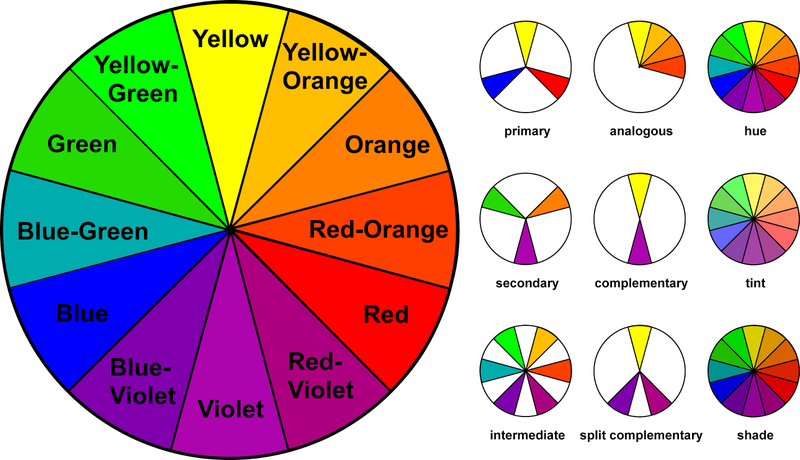
This is the basic color wheel and it will guide you in making color choices. You've probably seen it in school, but here's a quick refresher just in case you've forgotten.
Red, blue and yellow are primary colors. When you mix red and yellow, you get orange; mix blue and yellow, you get green; mix red and blue, you get violet. Orange, green and violet are hence called secondary colors. Tertiary colors like red-violet and blue-violet are derived by mixing a primary color with a secondary color.
All colors have tints and shades. A tint is the variation of that color when mixed with white; a shade is the variation of that color when mixed with black. But generally, you don't need to worry about tints and shades for basic color schemes, says Color Wheel Pro:
According to color theory, harmonious color combinations use any two colors opposite each other on the color wheel, any three colors equally spaced around the color wheel forming a triangle, or any four colors forming a rectangle (actually, two pairs of colors opposite each other). The harmonious color combinations are called color schemes – sometimes the term 'color harmonies' is also used. Color schemes remain harmonious regardless of the rotation angle.
In the color wheel, there's yet another separation that you need to be aware of so that you can understand color schemes better: warm and cool colors. Each has its own purpose to convey emotions. Warm colors exhibit energy and joy (best for personal messages), while cool colors convey calmness and peace (best for office use). The wheel itself can be divided easily to get an idea of which colors are warm and which ones cool, as demonstrated by Kissmetrics:
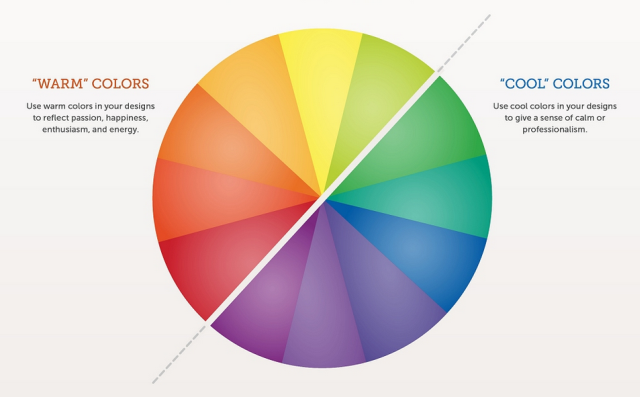
Master the Basic Color Schemes

Based on the wheel, there are a few basic rules to match colors. And they're actually pretty simple.
Complementary colors are any two colors opposite each other on the wheel. For example, blue and orange, or red and green.
These create a high contrast, so use them when you want something to stand out. Ideally, use one color as background and the other as accents. Alternately, you can use tints and shades here; a lighter tint of blue contrasted against a darker orange, for example.
Split complementary colors use three colors. The scheme takes one color and matches it with the two colors adjacent to its complementary color. For example, blue, yellow-orange and red-orange.
This scheme is ideal for beginners because it is difficult to mess up. That's because you get contrasting colors, but they aren't as diametrically opposite as complementary colors, says Tiger Color.
Analogous colors are any three colors next to each other on the wheel. For example, orange, yellow-orange, and yellow.
With analogous colors, it's best to avoid hues as they can be jarring. Instead, focus on tints of analogous colors. Another tip Color Wheel Pro shares is to avoid combining warm and cool colors in this scheme.
Triadic colors are any three colors that are equally apart on the color wheel. For example, red, yellow and blue.
The Triadic scheme is also high-contrast, but more balanced than complementary colors. The trick here, Decor Love says, is to let one color dominate and accent with the other two.
Tetradic or double complementary colors uses four colors together, in the form of two sets of complementary colors. For example, blue and orange is paired with yellow and violet.
This is the hardest scheme to balance, notes TheArtClasses:
It offers more color variety than any other scheme (but) if all four colors are used in equal amounts, the scheme may look unbalanced, so you should choose a color to be dominant or subdue the colors. Avoid using pure colors in equal amounts.
Understand Black and White with Monotones
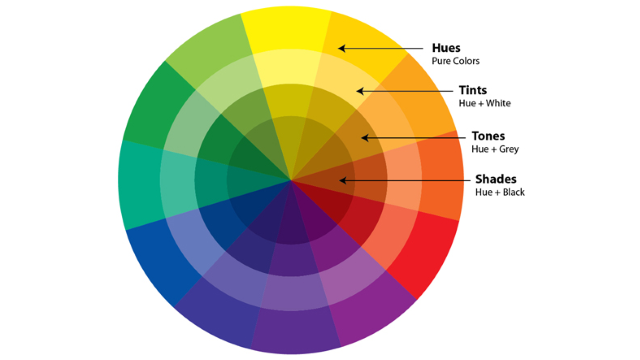
After you know the basic color schemes, you can step it up a notch with tints and shades. As we have already discussed, tints come from adding white to hues while shades come from adding black to hues. And this goes on till you get pure white or pure black. Apart from tints and shades, there are also tones, which is mixing the hue with grey.
Blacks and whites are used for "monochromatic color schemes," which are further divided into monotone chromatic and monotone achromatic. Colors On The Web has a great explanation of what this means:
Monotone Chromatic
A monotone color scheme is just one single hue and its variations in terms of tints, shades and saturation. Using saturation and tint/shade variations of a color is always good. However, in most cases I would advise against using a fully monochromatic scheme, as there is a risk of monotony. Using it with pure white or black can be efficient, though.
Monotone Achromatic
A monotone achromatic color scheme is a special instance of the monotone scheme which consists of only neutral colors ranging from black to white. A scheme like this can be efficient, but it can very easily look boring. Using an achromatic scheme with just one bright color for highlight can be very effectful.
Use Popular Color Palettes and Apps
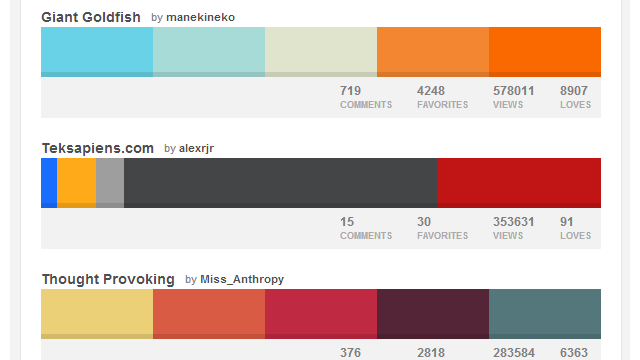
While the basics of color combinations are now clear to you, that doesn't mean you will always nail it. But like with anything, there's an easy way out!
Public speaking expert Zach Holman says you can use web sites where designers suggest color palettes, like ColourLovers. This portal shows popular color schemes, which you can quickly and easily incorporate for any need.
While that helps when starting from scratch, what do you do when you have a color in front of you but need to know what are its complements or triads? SwatchMatic for Android identifies any color you point your camera to (no need to take a photo), and suggests what you can match it with using the basics of the color wheel.
I couldn't find a similar app on the iPhone, but ColorSnap is a good option. You need to take a photo and the app then identifies various colors in it. Tap one and you'll see a palette of matching colors from paints company Sherwin Williams, which made the app. You can ignore that part and just use the palette for reference.
Finally, Color Matters says you needn't always rely on the color wheel and take inspiration from nature, or other elements around you:
Nature provides a perfect departure point for color harmony. In the illustration above, red yellow and green create a harmonious design, regardless of whether this combination fits into a technical formula for color harmony.
Apply Color Theory in Everyday Life
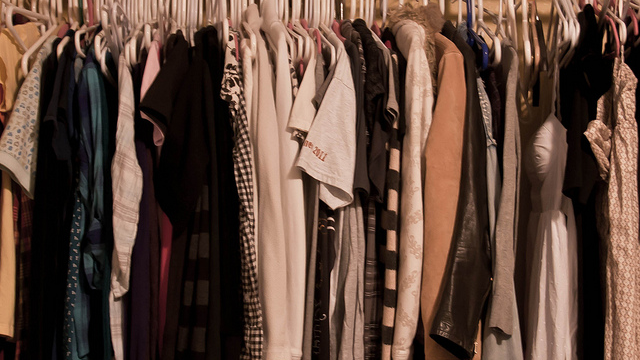
Now you have a basic idea of color theory, but what does that mean for your daily life? Essentially, these concepts help you figure out how to make things look better.
A common application is in the clothes you wear. Some people always seem to be able to dress well, while others wear clothes that clash or don't match. Print out the color wheel and stick it to your wardrobe's door. The next time you pick out one clothing item, just refer to the chart to see what colors in your closet will best complement it; and use the basics of warm and cool colors to convey the emotion you want to project. Of course, colors are only a part of learning to dress better. Style blog Kinowear has a few tips on how to use colors in clothing:
As a general rule of thumb you don't want to have more than three colors in your outfit. Use the right colors for your skin tone and coloration. Try different colors against your skin and learn which palettes look best on you. Also, get a second opinion. Never use holiday colors like red and green unless it is close to that holiday. Avoid matching gray colors with bright colors such as yellow.
Similarly, color theory can help you out in the office, whether it's jazzing up your resume for a job hunt or making your presentation and slides pop out. Again, the general rule of thumb is to restrict yourself to three colors or less. You should also check this color psychology chart to figure out what vibes your chosen colors will give out. And remember, it's going to be on a digital projector, so your colors need to be safe for that, as Holman points out:
Usually I look for bright colors that go well on projectors. That means colors with a lot of contrast. For example, choose a dark, a light, and an accent. That way you can layer the dark on the light and still read it from in the way back of the room you're giving the talk.
And of course, color theory is super useful when you are looking to paint your house or any major item in it. There are plenty of websites and plenty of professionals who will help you pick the right colors, but these three tips from Apartment Therapy are worth remembering at all times:
Three Rules To Keep in Mind:
• More than one color in a room can look great, but if you go in that direction, keep it to three colors maximum. If you are going with two bold colors, the third should be a neutral to give your eye a break.
• When choosing your colors start by choosing your boldest color, and then choose the others with the first color in mind.
• Don't be scared! Paint is not permanent and you can always change it.
Of course, these aren't the only uses for color theory. Colors and their combinations come up in life quite often and knowing these basics will serve you in picking a scheme that looks good to you as well as everyone else.
Photo by Nemo, Pong Suwan (Shutterstock), Kissmetrics, Operation Write Home, Tiger Color, Emily Hildebrand.
- Testemunhos
-
“ADSO= Inovação e Competência. Mais que um fornecedor de serviços são parceiros estratégicos.” Filipe Silva – FAFstone
-
“Pela seriedade, profissionalismo e empenho! Sabe "vestir" a nossa camisola!” António Ressurreição

